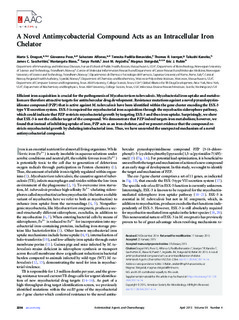| dc.contributor.author | Dragset, Marte Singsås | |
| dc.contributor.author | Poce, Giovanna | |
| dc.contributor.author | Alfonso, Salvatore | |
| dc.contributor.author | Padilla-Benavides, Teresita | |
| dc.contributor.author | Ioerger, Thomas R. | |
| dc.contributor.author | Kaneko, Takushi | |
| dc.contributor.author | Sacchettini, James C. | |
| dc.contributor.author | Biava, Mariangela | |
| dc.contributor.author | Parish, Tanya | |
| dc.contributor.author | Argüello, José M. | |
| dc.contributor.author | Steigedal, Magnus | |
| dc.contributor.author | Rubin, Eric J. | |
| dc.date.accessioned | 2017-09-27T07:21:28Z | |
| dc.date.available | 2017-09-27T07:21:28Z | |
| dc.date.created | 2015-08-05T12:36:44Z | |
| dc.date.issued | 2015 | |
| dc.identifier.citation | Antimicrobial Agents and Chemotherapy. 2015, 59 (4), 2256-2264. | nb_NO |
| dc.identifier.issn | 0066-4804 | |
| dc.identifier.uri | http://hdl.handle.net/11250/2456935 | |
| dc.description.abstract | Efficient iron acquisition is crucial for the pathogenesis of Mycobacterium tuberculosis. Mycobacterial iron uptake and metabolism are therefore attractive targets for antitubercular drug development. Resistance mutations against a novel pyrazolopyrimidinone compound (PZP) that is active against M. tuberculosis have been identified within the gene cluster encoding the ESX-3 type VII secretion system. ESX-3 is required for mycobacterial iron acquisition through the mycobactin siderophore pathway, which could indicate that PZP restricts mycobacterial growth by targeting ESX-3 and thus iron uptake. Surprisingly, we show that ESX-3 is not the cellular target of the compound. We demonstrate that PZP indeed targets iron metabolism; however, we found that instead of inhibiting uptake of iron, PZP acts as an iron chelator, and we present evidence that the compound restricts mycobacterial growth by chelating intrabacterial iron. Thus, we have unraveled the unexpected mechanism of a novel antimycobacterial compound. | nb_NO |
| dc.language.iso | eng | nb_NO |
| dc.publisher | American Society for Microbiology | nb_NO |
| dc.title | A novel antimycobacterial compound acts as an intracellular iron chelator | nb_NO |
| dc.type | Journal article | nb_NO |
| dc.type | Peer reviewed | nb_NO |
| dc.description.version | acceptedVersion | nb_NO |
| dc.source.pagenumber | 2256-2264 | nb_NO |
| dc.source.volume | 59 | nb_NO |
| dc.source.journal | Antimicrobial Agents and Chemotherapy | nb_NO |
| dc.source.issue | 4 | nb_NO |
| dc.identifier.doi | 10.1128/AAC.05114-14 | |
| dc.identifier.cristin | 1256479 | |
| dc.relation.project | Norges forskningsråd: 223255 | nb_NO |
| dc.relation.project | Norges forskningsråd: 220836 | nb_NO |
| dc.description.localcode | Copyright © 2015, American Society for Microbiology. All Rights Reserved. | nb_NO |
| cristin.unitcode | 194,66,15,0 | |
| cristin.unitcode | 194,65,15,30 | |
| cristin.unitcode | 194,65,15,0 | |
| cristin.unitname | Institutt for bioteknologi | |
| cristin.unitname | Centre of Molecular Inflammation Research (SFF-CEMIR) | |
| cristin.unitname | Institutt for kreftforskning og molekylær medisin | |
| cristin.ispublished | true | |
| cristin.fulltext | original | |
| cristin.fulltext | preprint | |
| cristin.qualitycode | 2 | |
